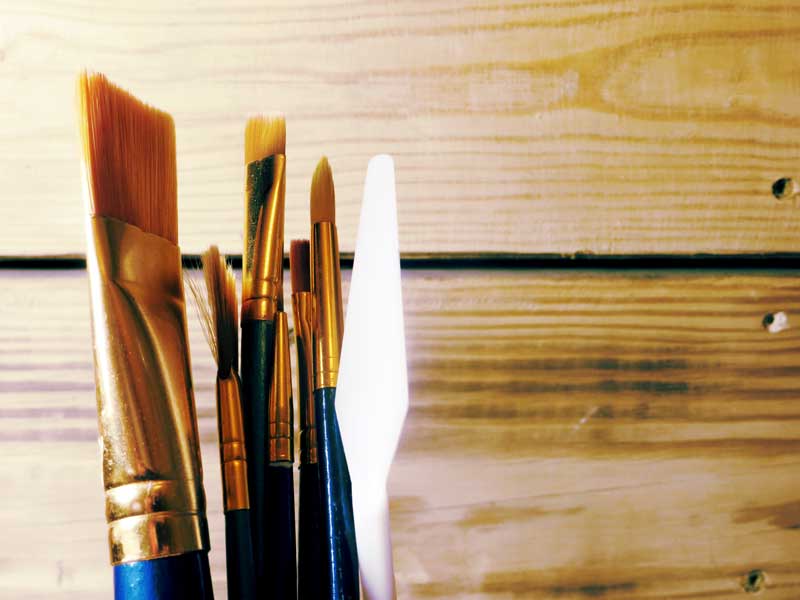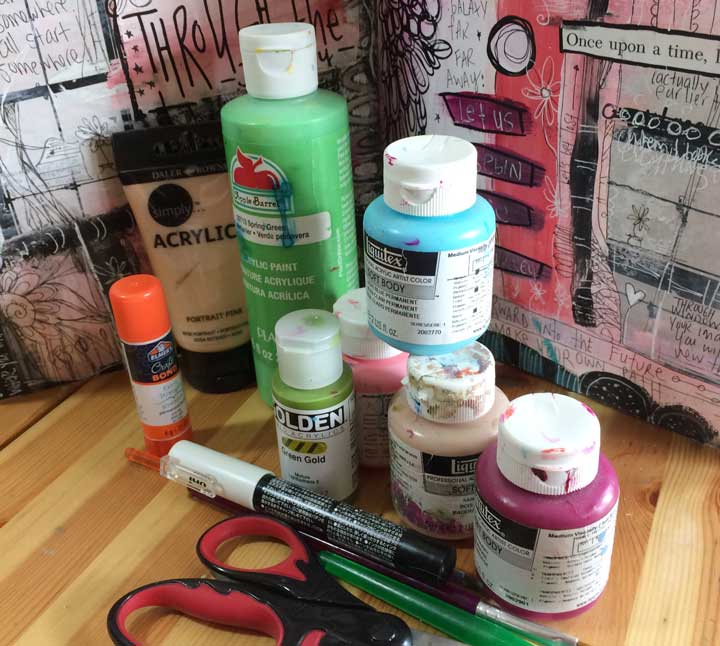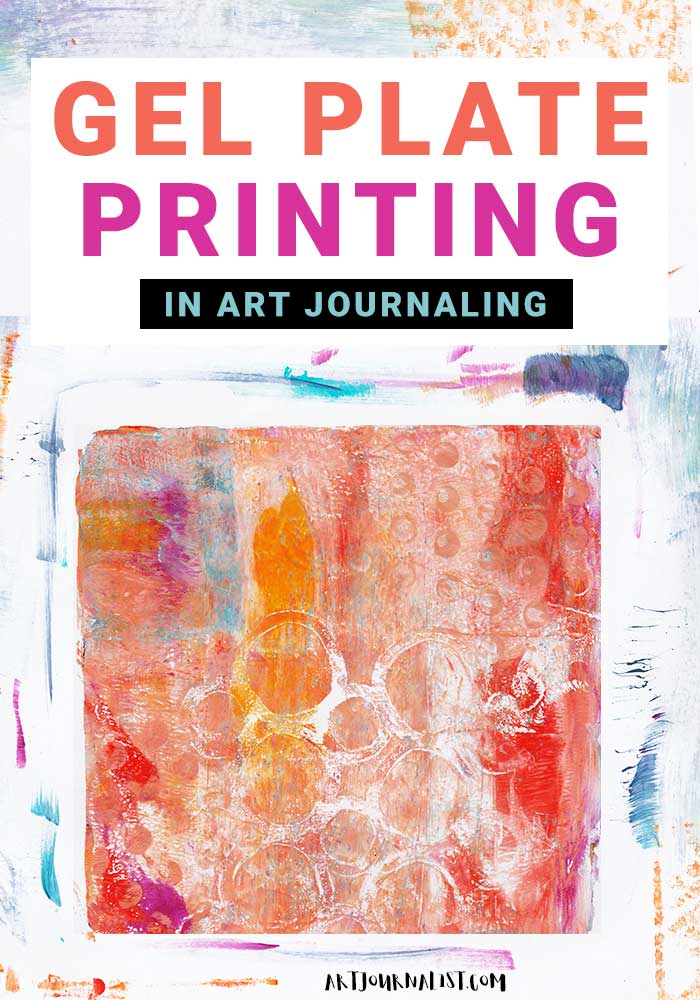12 Tips for Working With Acrylic Paint in Your Art Journal
As an Amazon Associate I earn from qualifying purchases. Thank you for your support!

Acrylic paint is cheap, readily available (even my grocery store sells it!) and probably one of my favorite mediums to utilize in my fine art journals considering of its texture and the vivid vivid colors.
Today I thought I would share some of my tips for working with acrylic paint to help you use it in your art journals.
Here are My Top 12 Tips for Working With Acrylic Pigment:
ane. Go on The Pigment From Drying Out While Y'all're Working:
Acrylic paints dry out VERY quickly. If you lot're working on a project, simply squeeze out a small amount at a time – and consider using plastic wrap to encompass up your palette if you're waiting for a page to dry before starting the next one.
You can as well mist your palette with water in a small spray bottle, but that tin can h2o it downwardly a piddling if you're non besides careful.
two. Take Care of Your Brushes:

When switching betwixt colors, y'all may want to rinse your acrylic paint brushes in h2o – but you don't actually want to mix water and acrylic paint (unless you lot're intentionally going for the effect!) – and then be sure to have some paper towels handy for blotting your brushes dry.
Also, be sure that y'all clean your brushes thoroughly as soon equally you're washed painting – acrylic pigment once dry will destroy those brushes in no time!
Annotation: No need for solvents or paint thinners when cleaning brushes used with acrylic paint – if you lot want, add a few drops of dish detergent for stubborn brushes that won't come clean.
3. Experiment With Unlike Finishes:
Acrylic paint sold at well-nigh craft stores will come in different finishes,ie: matte vs. semi-gloss. I just discovered this by accident 1 twenty-four hour period while painting and realized one of the bottles was labeled differently!
At present that I've realized there are different finishes and have played around with them, I know to take hold of the semi-gloss bottles or matte depending on what the project I'm doing 🙂
Experiment with the different types to notice out which kind y'all like – you tin can even mix them together in virtually cases without any adverse effects.
iv. Mix Colors Consistently:
If you tend to mix up colors on your palette completely randomly – a trivial dab of this, a little dab of that – you may find yourself with a beautiful colour that tin't exist duplicated.
While at that place's no harm in mixing colors randomly if that'south your style, try counting "drops" or "dabs" in your mixture to consistently get the same colour every time.
If need be, write it down so you don't forget! (Me, existence the forgetful type, finds this to be very helpful!)
5. It's Okay to Use Cheap Paint:

Some people are going to disagree with me on this one. And yeah, the more y'all spend generally the better quality you are going to encounter in your paint (information technology by and large will terminal a little longer also as you don't demand as much paint). Merely you don't have to spend a fortune!
I honey brands like Liquitex and Golden, simply for beginners it can be an expensive investment.
Using inexpensive arts and crafts pigment brands which average around $1-$3 a bottle will work just fine! When I am just experimenting, it works fine for what I'm doing. 🙂
Now, if you're creating a masterpiece for an art exhibit to sell, and so I'd go with the more expensive paint…merely for me and my kids making journals (and my kids tend to waste matter a lot of paint) – cheap paint works but as well in those cases.
6. Avoid Pages From Sticking Together:
Gummy pages is a problem a lot of people who are new to using acrylic paint in their journals have.
Keeping waxed paper betwixt pages is one pick – you can also dust a lite coat of infant powder on the pages which volition help you lot avoid pages sticking together – just exist certain to utilize the baby powder after the page is completely dry!
7. Become Creative With Different Brushes:
I dearest mixing up the different types of brushes I use. From big fat brushes to skinny little ones, you'll find each can really arrive fun to mix it up.
You tin read more almost how yous can use the different types of brushes available hither: Acrylic Paint Brushes 101: Agreement the Different Types and How to Use Them.
8. Add together Texture With Household Objects:
Acrylic paints practice really well with "texturing" and then don't exist agape to experiment with some unusual textures or household objects.
I've found that painting things with some acrylic pigment to use as stamps can be a lot of fun, or you tin can also old credit/gift cards to apply as a bootleg palette pocketknife.
Get through your home looking for unique and unusual items and you lot'll exist amazed at what creative things you can come up with!
You tin also have a lot of fun with creating background textures with gel plate press!

9. Use a heat gun or hair dryer to advance drying fourth dimension:
Inpatient? Me also! A craft heat tool gun, on depression setting and at least 4-6 inches abroad from your painting, should help things dry up a little faster (or at least give you something to exercise while you wait!).
I honey the Nicole Multipurpose Heat Gun and have been using it for years – it has been wonderful to speed up the drying process on some of my work equally I wait for layers to dry!
Exist sure when using that you utilise the estrus evenly to each area so information technology dries consistently to foreclose crackling. If you become likewise close or stay on any 1 spot too long, you may discover the pigment starting to bubble or crack.
10. You Can Mix Glue & Acrylic Paint for Collaging:
I use obviously old white mucilage and acrylic paint together all the time when collaging magazine pictures into my art.
First I castor the glue on to the back of the image, then apply it to the folio and then paint over the edges with a mixture of the glue and paint together to help the photo blend in with the background.
While evidently white glue works well, I've found that I also like to apply Liquitex, which is basically a clear acrylic pigment that works as an agglutinative as well.
11. Prime number Thin Pages With Acrylic Gesso Beginning:
If y'all're using a wet media journal or sketchbook or an old altered book with thick pages, then you don't ever demand to employ gesso to the pages get-go.
Just if y'all're working with a journal or book that has thin pages, you'll want to gesso these pages beginning for a few reasons:
one. That the paint won't bleed through to the other side
two. The pages will be less likely to tear.
3. More brilliant colors as the paint will not be absorbed into the newspaper as much.
12.Put wax paper underneath your pages y'all're working on:
To prevent paint from making previous pages y'all've done and the pages you've yet to do from sticking together, identify sheets of wax paper underneath your current pages. This will help prevent information technology from sticking and making a mess.
Do you have whatever tips for using acrylic paints that you'd similar to share? I'd honey to hear them in the comments section below !
And of course, if you accept whatsoever questions near working with acrylic paints, feel costless to ask them in our Facebook group! I'm always happy to answer questions you may accept!
Source: https://artjournalist.com/acrylic-paint-tips/
0 Response to "12 Tips for Working With Acrylic Paint in Your Art Journal"
Post a Comment